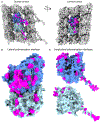The Tubulin Code in Microtubule Dynamics and Information Encoding
- PMID: 32634400
- PMCID: PMC11042690
- DOI: 10.1016/j.devcel.2020.06.008
The Tubulin Code in Microtubule Dynamics and Information Encoding
Abstract
Microtubules are non-covalent mesoscale polymers central to the eukaryotic cytoskeleton. Microtubule structure, dynamics, and mechanics are modulated by a cell's choice of tubulin isoforms and post-translational modifications, a "tubulin code," which is thought to support the diverse morphology and dynamics of microtubule arrays across various cell types, cell cycle, and developmental stages. We give a brief historical overview of research into tubulin diversity and highlight recent progress toward uncovering the mechanistic underpinnings of the tubulin code. As a large number of essential pathways converge upon the microtubule cytoskeleton, understanding how cells utilize tubulin diversity is crucial to understanding cellular physiology and disease.
Keywords: CCP; TTLL; detyrosination; dynein; glutamylation; glycylation; kinesin; microtubule; microtubule associated proteins; motors; severing; tubulin code; tubulin isoforms; tubulin post-translational modifications; tubulin tyrosine ligase; tyrosination.
Published by Elsevier Inc.
Figures




References
-
- Aillaud C., Bosc C., Peris L., Bosson A., Heemeryck P., Van Dij J., Le Friec J., Boulan B., Vossier F., and Sanman LE. (2017). Vasohibins/SVBP are tubulin carboxypeptidases (TCPs) that regulate neuron differentiation. Science 358, 1448–1453. - PubMed
-
- Arce CA, Rodriguez JA, Barra HS, and Caputo R (1975). Incorporation of L-tyrosine, L-phenylalanine and L-3,4-dihydroxyphenylalanine as single units into rat brain tubulin. Eur J Biochem 59, 145–149. - PubMed
Publication types
MeSH terms
Substances
Grants and funding
LinkOut - more resources
Full Text Sources
Other Literature Sources
Research Materials

